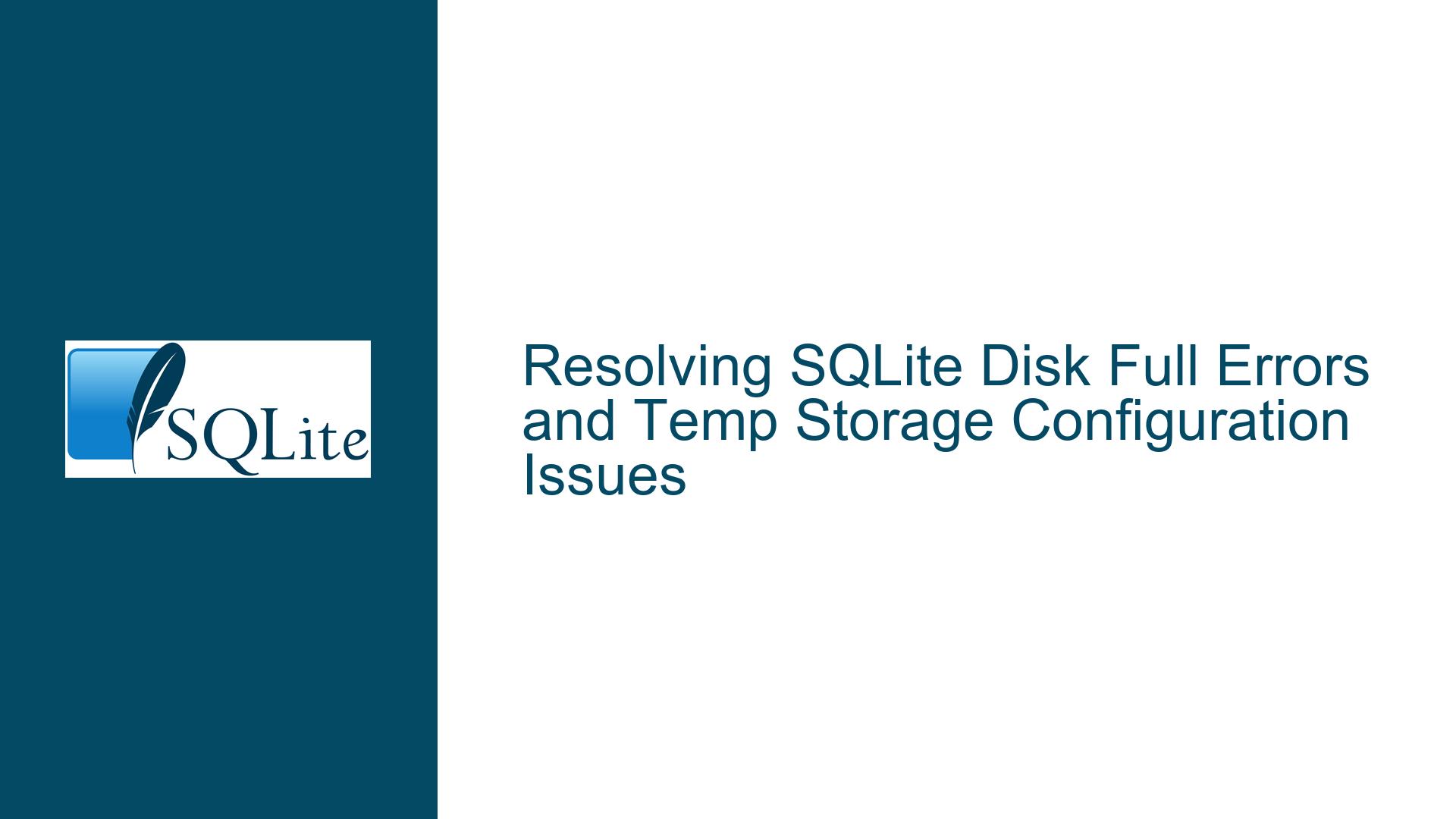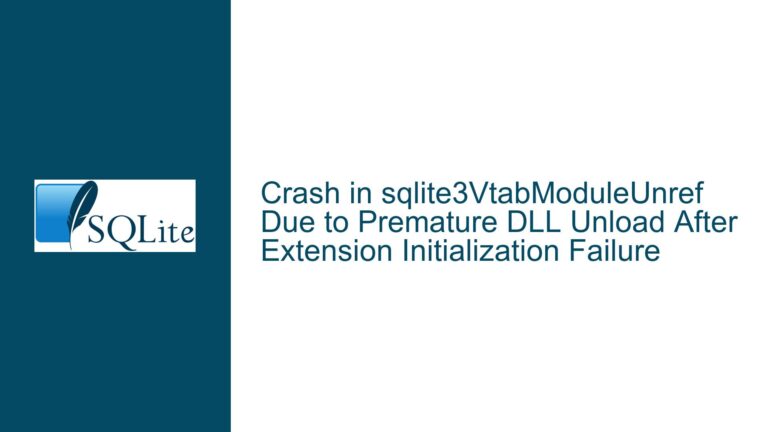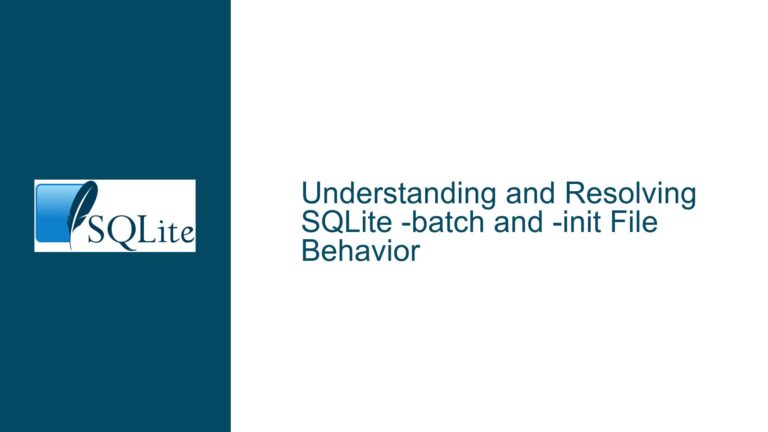Resolving SQLite Disk Full Errors and Temp Storage Configuration Issues
Understanding SQLite Temporary Storage Mechanics and Error Scenarios
SQLite relies heavily on temporary storage to execute operations such as VACUUM, index creation, large joins, and sorting. These operations generate intermediate data that must be stored temporarily. The database engine uses a hierarchy of storage locations for this purpose, including system-defined temporary directories (e.g., /tmp on Unix-like systems), user-specified directories via environment variables or pragmas, and the current working directory as a fallback. The selection of these locations is critical because insufficient space in the chosen directory leads to "disk full" or "disk I/O error" messages.
A key challenge arises when SQLite’s default temporary storage locations are misconfigured or lack sufficient capacity. For example, if the system’s /tmp directory is mounted on a small partition, large operations like VACUUM may exhaust available space. Worse, when SQLite falls back to the current directory (due to unwritable primary temp locations), users might encounter errors that appear to indicate hardware failure but are actually transient storage allocation failures. This is exacerbated when the current directory resides on a read-only filesystem, as temporary file creation attempts will fail outright.
The absence of detailed error messages compounds the problem. SQLite’s default error reporting often omits the specific file path responsible for the failure, leaving users to guess which directory or file caused the issue. For instance, an OperationalError: database or disk is full message without a path forces users to manually inspect all potential temp directories, a time-consuming and error-prone process. This lack of clarity is particularly problematic in applications where multiple databases or temp directories are in use, as the root cause of the error becomes obscured.
Diagnosing Causes of Disk Full and I/O Errors in SQLite Operations
Insufficient Temporary Storage Allocation
The most common cause of disk-related errors is inadequate space in the directory SQLite selects for temporary files. Operations like VACUUM require temporary storage equal to the size of the original database. If the default temp directory (e.g., /tmp) has limited space, this operation will fail. Similarly, sorting large datasets or creating indexes generates temporary files proportional to the dataset size. When the temp directory’s free space is smaller than the working dataset, SQLite cannot complete the operation.
Misconfigured or Unavailable Temporary Directories
SQLite follows a strict priority order when selecting temporary storage locations:
- Directory specified by the
SQLITE_TMPDIRenvironment variable. - Directory set via the deprecated
temp_store_directorypragma. - System-specific default temp directories (e.g.,
/var/tmp,/usr/tmp). - The current working directory (
.).
If the first three options are unwritable or unspecified, SQLite defaults to the current directory. This becomes problematic when the application lacks write permissions in the current directory or when that directory resides on a read-only volume. For example, a user backing up a read-only directory might trigger a disk I/O error because SQLite attempts to write temporary files to the same read-only location.
Lack of Error Context in Disk-Related Failures
SQLite’s error messages often omit critical details such as the path of the file that caused the failure. Without this information, users cannot quickly identify whether the issue stems from the database directory, a system temp directory, or an application-specific location. This ambiguity forces developers to reverse-engineer SQLite’s temp directory selection logic or manually inspect all possible paths—a process that delays resolution and increases downtime.
Deprecated Configuration Mechanisms
The temp_store_directory pragma, historically used to set the temp directory, is deprecated and subject to removal in future SQLite versions. Applications relying on this pragma face compatibility risks. Furthermore, environment variables like SQLITE_TMPDIR may not be propagated correctly in all execution environments (e.g., restricted shells, containerized applications), leading to inconsistent behavior across deployments.
Solutions for Configuring Temp Storage and Mitigating Disk Errors
Step 1: Explicitly Set the Temporary Directory
Override SQLite’s default temp directory selection by setting the SQLITE_TMPDIR environment variable to a known writable location with sufficient space. In Python, this can be done programmatically before initializing the database connection:
import os
os.environ["SQLITE_TMPDIR"] = "/path/to/writable/temp/dir"
Ensure the directory has enough free space to accommodate temporary files generated by large operations. As a rule of thumb, allocate at least twice the size of the largest expected database file.
Step 2: Prioritize the Database Directory for Temp Files
Modify the application to use the database’s parent directory as the temp location. Since the database directory is already writable (required for journal files), it is a reliable fallback. In Python:
import sqlite3
db_path = "/path/to/database.db"
temp_dir = os.path.dirname(db_path)
os.environ["SQLITE_TMPDIR"] = temp_dir
conn = sqlite3.connect(db_path)
This approach avoids read-only errors caused by falling back to the current directory while leveraging a known-good location.
Step 3: Preflight Checks for Temp Directory Capacity
Before executing storage-intensive operations, verify that the temp directory has sufficient space. Use platform-specific APIs to check free space:
import shutil
def check_temp_space(temp_dir, required_bytes):
stats = shutil.disk_usage(temp_dir)
if stats.free < required_bytes:
raise Exception(f"Insufficient space in {temp_dir}")
check_temp_space(os.environ["SQLITE_TMPDIR"], 2 * 1024**3) # 2 GB
Estimate the required space based on the operation. For VACUUM, ensure the temp directory has at least the size of the database file. For sorts and indexes, estimate based on dataset size.
Step 4: Implement Enhanced Error Logging with File Paths
Use SQLite’s logging callback to capture detailed error information, including the paths of files involved in I/O failures. Even in Python 2, this can be achieved via ctypes:
import ctypes
import sqlite3
SQLITE_CONFIG_LOG = 16
log_callback = ctypes.CFUNCTYPE(None, ctypes.c_void_p, ctypes.c_int, ctypes.c_char_p)
def sqlite_log_handler(user_data, err_code, message):
print(f"SQLite Error {err_code}: {message}")
handler_ptr = log_callback(sqlite_log_handler)
ctypes.cdll.sqlite3.sqlite3_config(SQLITE_CONFIG_LOG, handler_ptr, None)
conn = sqlite3.connect(":memory:")
This logs all SQLite errors, including temporary file I/O issues, providing visibility into which paths caused failures.
Step 5: Enforce Temp File Cleanup Policies
SQLite automatically deletes temporary files when the database connection closes. However, crashes or SIGKILLs may leave orphaned files. Mitigate this by:
- Using
DELETEjournal mode (default in SQLite 3.8+), which removes temporary files on transaction commit. - Periodically purging stale files in the temp directory:
import glob
import time
temp_dir = os.environ["SQLITE_TMPDIR"]
now = time.time()
for f in glob.glob(os.path.join(temp_dir, "sqlite_*")):
if os.stat(f).st_mtime < now - 86400: # Older than 1 day
os.remove(f)
Step 6: Migrate from Deprecated temp_store_directory Pragma
Replace reliance on PRAGMA temp_store_directory with environment variables or runtime configuration. For example, instead of:
conn.execute("PRAGMA temp_store_directory = '/path/to/tmpdir'")
Set SQLITE_TMPDIR at the process level, as shown in Step 1. This ensures compatibility with future SQLite versions and avoids pragma-related deprecation warnings.
Step 7: Optimize Query Patterns to Reduce Temp File Usage
Re-architect queries to minimize temporary storage requirements:
- Use
EXPLAIN QUERY PLANto identify sorts and joins that spill to disk. - Add indexes to eliminate large in-memory sorts.
- Batch large
INSERToperations to avoid excessive transaction logs. - Use
VACUUM INTOinstead of in-placeVACUUMto control temporary file location:
VACUUM INTO '/path/to/backup.db';
Step 8: Evaluate Compile-Time SQLite Configuration
If building SQLite from source, adjust compile-time parameters to optimize temp file handling:
SQLITE_DEFAULT_TEMP_CACHE_SIZE: Controls the number of pages cached in memory before spilling to disk. Increasing this reduces temp file I/O but raises memory usage.SQLITE_DIRECT_OVERFLOW_READ: Bypasses the page cache for large BLOBs, reducing memory pressure during reads.
Step 9: Monitor and Alert on Temp Directory Health
Implement real-time monitoring for the temp directory’s free space. Tools like inotify (Linux) or FileSystemWatcher (Windows) can trigger alerts when free space drops below a threshold. In Python:
import pyinotify
class TempSpaceHandler(pyinotify.ProcessEvent):
def process_IN_MODIFY(self, event):
free_space = shutil.disk_usage(temp_dir).free
if free_space < warning_threshold:
send_alert(f"Low space in {temp_dir}: {free_space} bytes left")
wm = pyinotify.WatchManager()
handler = TempSpaceHandler()
notifier = pyinotify.Notifier(wm, handler)
wdd = wm.add_watch(temp_dir, pyinotify.IN_MODIFY)
notifier.loop()
Step 10: Fallback Strategies for Read-Only Environments
In environments where the database directory is read-only (e.g., embedded devices), configure a RAM disk for temporary files. On Linux:
os.environ["SQLITE_TMPDIR"] = "/dev/shm"
This uses shared memory for temp files, avoiding disk I/O entirely. Adjust the RAM disk size via /etc/fstab to match operational requirements.
By systematically applying these solutions, developers can eliminate ambiguous disk errors, ensure reliable temp file management, and maintain optimal performance across diverse SQLite deployments.






